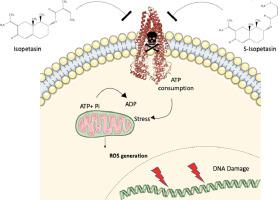Phytomedicine ( IF 7.9 ) Pub Date : 2020-03-10 , DOI: 10.1016/j.phymed.2020.153196 Sara Abdelfatah , Madeleine Böckers , Maitane Asensio , Onat Kadioglu , Anette Klinger , Edmond Fleischer , Thomas Efferth

|
Background
A major problem of cancer treatment is the development of multidrug resistance (MDR) to chemotherapy. MDR is caused by different mechanisms such as the expression of the ABC-transporters P-glycoprotein (P-gp, MDR1, ABCB1) and breast cancer resistance protein (BCRP, ABCG2). These transporters efflux xenobiotic toxins, including chemotherapeutics, and they were found to be overexpressed in different cancer types.
Purpose
Identification of novel molecules that overcome MDR by targeting ABC-transporters.
Methods
Resazurin reduction assay was used for cytotoxicity test. AutoDock 4.2. was used for molecular docking. The function of P-gp and BCRP was tested using a doxorubicin uptake assay and an ATPase assay. ROS generation was detected using flow cytometry for the measurement of H2DCFH-DA fluorescence. Annexin/PI staining was applied for the detection of apoptosis. Bioinformatic analyses were performed using LigandScout 3.12. software and DataWarrior software.
Results
In our search for new molecules that selectively act against resistant phenotypes, we identified isopetasin and S-isopetasin, which are bioactive natural products from Petasites formosanus. They exerted collateral sensitivity towards leukemia cells with high P-gp expression in CEM/ADR5000 cells, compared to sensitive wild-type CCRF-CEM leukemia cells. Also, they revealed considerable activity towards breast cancer cells overexpressing breast cancer resistance protein, MDA-MB-231-BCRP clone 23. This motivated us to investigate whether the function of P-gp was inhibited. In-silico results showed the compounds bound with high affinity and interacted with key amino acid residues in P-gp . Then, we found that the two compounds increased doxorubicin accumulation in P-gp overexpressing CEM/ADR5000 by three-fold compared to cells without inhibitor. P-gp-mediated drug efflux was ATP-dependent. Isopetasin and S-isopetasin increased the ATPase activity of human P-gp in a comparable fashion as verapamil used as control P-gp inhibitor. As isopetasin and S-isopetasin exerted dual roles, first as cytotoxic compounds and then as P-gp inhibitors, we suggested that their P-gp inhibition is part of a larger complex of mechanisms to induce cell death in cancer patients. P-gp dysfunction induces mitochondrial stress to generate ATP. Upon continuing stress by P-gp inhibition, the mitochondria generate reactive oxygen species (ROS). Initially established for verapamil, this theory was validated in the present study for isopetasin and S-isopetasin, as treatment with the two candidates increased ROS levels in CEM/ADR5000 cells followed by apoptosis.
Conclusion
Our study highlights the importance of isopetasin and S-isopetasin as novel ROS-generating and apoptosis-inducing P-gp inhibitors.



























 京公网安备 11010802027423号
京公网安备 11010802027423号